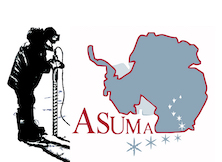Campagne 2015-2016
The traverse is planned for 30 days. The route has been discussed and improved according to observations made directly on the field. We proposed to perform a deeper analysis along the first 150km from the coast, were the Glacioclim Samba observatory (http://www-lgge.ujf-grenoble.fr/ServiceObs/SiteWebAntarc/glacioclim-samba.php) already offers long term information on temporal and spatial variability of accumulation. We also analyzed satellite images from the upper part of the Mertz glacier and decided to avoid the lowest regions because observation of numerous large crevasses suggests that this region will be hard to cross with tractors and caravans.
Figure 1: Vincent Jomelli and Laurent Arnaud set up the mast of the 50-m drill
During the 2015-16 summer, we tested the most important and/or limitant equipments that will be used during the traverse. The drill was tested until 50m depth, in order to check its limitations and to define the best protocols for drilling operations. The 50 m depth was reached in less than 2 days.
Figure 2: Set up of the drill cable in the pulley
Figure 3: Tuning of the core catchers and cutters
We also positively tested a new lightweight drill, to perform 2-m deep firn cores in one minute in any kind of snow. We drilled 3 new firn cores until 20-m depth, at a site located at 63-km from Cap Prud’homme. These cores will be compared to those drilled during the previous field campaign. These new cores will allow getting informations on gradients observed in chemical and isotopic contents between 0 m asl and 1500 m asl.
The mobile units acquired by the Equipex Climcor project and designed for drilling operation and for the post processing of firn and ice cores have been controled to verify whether they meet the low contamination requirements needed for drilling operations. A protection tarp for operations in pits was tested demonstrating that it is robust for large winds.
Figure 4 : Test of the protection tarp
An automatic camera system initally designed to follow changes in the roughness length was tested. We observed that cameras may not be adapted for long term survey where blowing snow and frequent whiteout situations impede a continuous observation of the surface.
Figure 5: Laurent Arnaud tunes the automatic camera
Finally, Laurent Arnaud tested a new home-designed multi-spectral albedometer at Dome C. This sensor is expected to be installed on automatic weather stations located in remote areas.
This field campaign resulted fully positive and our analysis gives optimistic perspectives for next year traverse.
Mis à jour le 18 mars 2022


